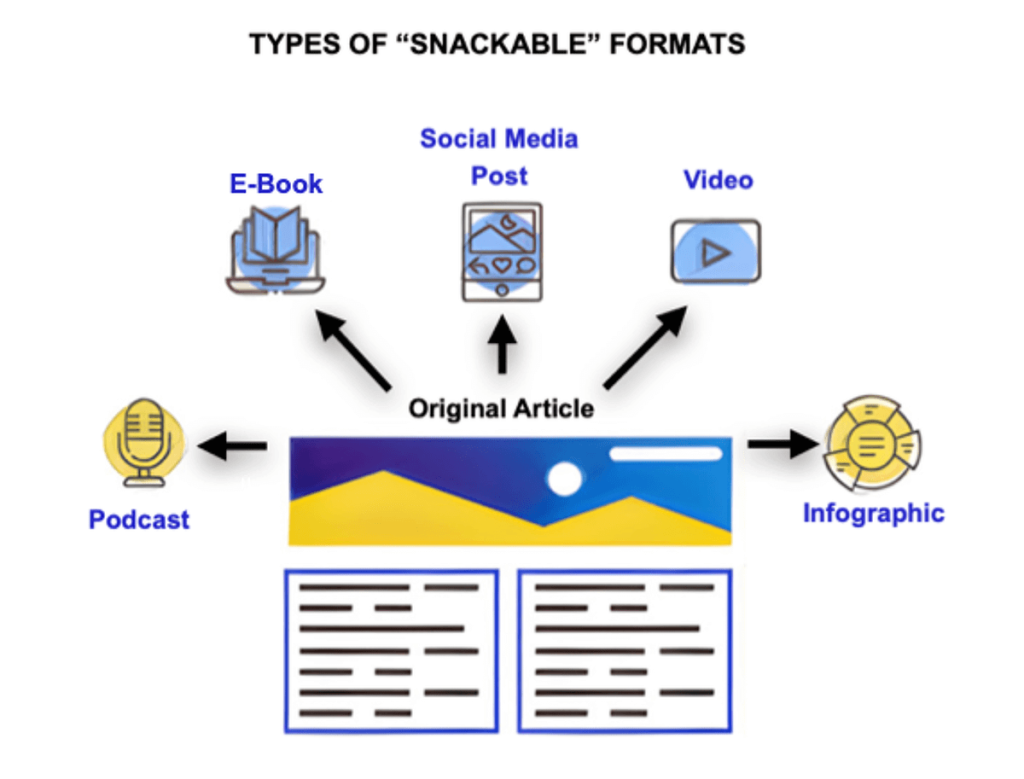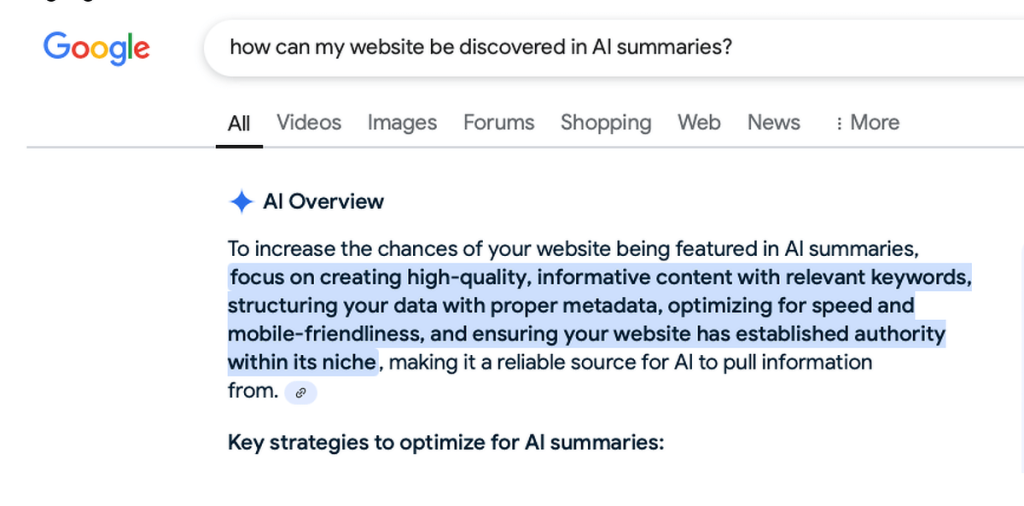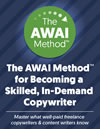Smart Content Repurposing Strategies

Like a book can be made into a movie, and then a spinoff series made from the movie, your digital content can have many lives.
The trick is in how you repurpose it.
When you repurpose content …
- you adapt existing material into different formats for additional platforms,
- revive previously popular posts for new life on your website or in your email,
- or reframe ideas to reach a different audience.
This lends more life to your content while expanding your reach to a broader audience.
In the past, repurposing often consisted of slapping your blog post onto a social media platform and calling it a day. But it’s 2025 and the game has become far more sophisticated.
When you repurpose content, part of your goal should be to offer new value, not just repackage older content. The best strategy to employ now is creating original pieces of content intentionally designed with repurposing in mind from the beginning.
Work Smarter, Not Harder
AI tools, shifting audience habits, and shorter attention spans mean you need to work smarter, not harder.
When you repurpose content, you’ll save time, but you’ll also give yourself more opportunities to grow your audience, maximize impact, and get the most value from your efforts (Semrush 2023). An effective content marketing strategy demands a constant stream of fresh material, and mastering repurposing helps you keep up without burning out.

Audiences Are Hungry for Snackable Content
Not everyone has the time, or patience, to read your 2,000-word masterpiece in one sitting.
That doesn’t mean long-form content is outdated or ineffective. Your most dedicated audience members will continue to appreciate it. But when you repurpose your long-form content into shorter, shareable pieces that highlight your key takeaways, you can reach more people.
Creating “snackable content” from your long-form content can attract those with busy schedules and a penchant for scrolling, and improve the overall impact and reach of your longer piece.
Another way to look at this is like meal prep for your content calendar. Just as an elaborate holiday dinner can yield days of tasty leftovers, an article you cook up can yield additional sound bites for social media, a quick-read email newsletter, or a full-blown video script.
Snackable content is designed to grab attention quickly and keep audiences engaged without overwhelming them. The food metaphor fits because it reflects how people “consume” content while scrolling for inspiration, information, or entertainment. Quick reads and attention-grabbing visuals are highly shareable and effective.
What Kind of Content Is Prime for Repurposing?
- Evergreen Content
- Books
- Presentations
- Webinars
- Interviews
- Speeches or Key Notes
- Podcasts
- Video Clips
- Blog Posts
- Vlogs/Reels
- Long-form Articles
- Social Media Posts

If you’re ready to get more mileage out of your content without pulling all-nighters, here are strategies that are currently working and well worth your time …
Repurpose Your Content with 8 Smart Strategies
1. Start with Research
Hands down, research is the foundation of any successful marketing effort. Don’t repurpose content just because it’s there. Use website and social media analytics tools to determine your top-performing pieces, then repurpose those.
- Incorporate new and relevant information to give them new life on your website.
- Break them into smaller pieces to share with social media audiences.
- Play with different formats to reach new audiences or to bring home key points in a new way.
According to HubSpot, repurposed content often generates more leads than original content, underscoring its effectiveness for reaching more customers and prospects.
2. Create Eye Candy
Visual formats work well because people tend to remember them better and share them more often. A report by Venngage found that 65% of marketers believe visual content is key to their strategy. Here are a few ideas:
- Social Media Carousels — Turn how-to guides into swipe-able slides for Instagram or LinkedIn.
- Short-Form Video — Summarize your blog’s main point in an Instagram reel or YouTube short. You could even turn it into a Loom video to send through email.
- Infographics — Tools like Canva make it easy to transform data-heavy content like quotes, charts, or stats into eye-catching infographics. Step-by-step blog posts can be repurposed for platforms like Pinterest in this way.
- Memes and GIFs — These formats are visually entertaining and perfect for sharing.
3. Leverage AI for Ideas
AI tools like ChatGPT, Jasper, and Copy.ai can assist you in turning long-form content into nibbles faster than you can say “repurpose.”
They help with tasks such as …
- breaking up blogs into social media posts. You can use these tools to create Instagram captions or the text for LinkedIn carousels, for example.
- pulling images from longer posts and adding new captions for Bluesky, X, and other platforms.
- rewriting old posts with new keywords to boost SEO.
- creating personalized clips of content for different audiences. These types of clips thrive on platforms like YouTube, Triller, Instagram, or TikTok (provided it remains available).
Imagine you have a 2,000-word blog post on productivity tips. You could use an AI tool to transform it into an outline for a week’s worth of LinkedIn posts — each focused on one tip with a unique example or story. Prompt AI to generate a list of topics, and then personalize each with your ideas.
When using AI, always edit the output to reflect your voice, experiences, and brand. Relying on generic or sub-par AI copy can backfire. If it sounds robotic or like everyone else, it could hurt your reputation. Make sure anything you publish pops with your original thought leadership.
4. One Piece of Content, Multiple Platforms
Every platform has its personality and guidelines, and your content strategy must play nice with them. For example …
- LinkedIn = Thought leadership posts with tips or case studies.
- YouTube / TikTok = Quick hacks, fun and instructive visuals, or behind-the-scenes insights.
- Pinterest = Infographics and step-by-step guides.
- Instagram Stories = Polls, quizzes, and engagement-driven snippets.
Posting on different platforms will help you reach different segments of your audience. Keep in mind, some of your audience likely follows you across multiple platforms, so take the time to tailor your posts for each platform to keep those folks engaged.
5. Audio Is Booming
Your written content can be transformed into a podcast or other sound bites for the audio-loving crowd. Think …
- AI Voiceovers — Turn blogs into quick podcasts using AI tools such as Podbean.
- Highlight Reels — Clip the best sound bites from webinars or interviews using OpusPro or other software.
- Audiograms — Pair short audio clips with visuals for social media with tools such as Veed for AI clip generation.
People love to listen while they’re commuting, working out, or, like me, avoiding chores. One hundred million Americans now listen to at least one podcast every week, accounting for 34% of Americans 12 years of age and over (Forbes 2024).
6. Optimize for AI Search (Hello, ChatGPT)
AI-powered search tools are changing how people find content. Many people are forgoing Google and other traditional search engines in favor of conducting their queries from inside a chat window.
In 2023, around 13 million adults in the United States claimed to have used generative artificial intelligence (AI) as their primary tool for online search. This number is projected to reach over 90 million online users by 2027 (Statista 2023). Knowing how to rank in AI-driven platforms is now a necessity, not a luxury.
Certain techniques can help AI discover your content more effectively:
- FAQs and Q&A Formats — These structures work great with AI because they match how people phrase their search questions. Directly answering these queries in your copy helps AI locate your content more easily.
- Structured Lists and Step-by-Step Sections — Use organized formats like bullet points and numbered steps to make your content easier for AI to find and display.
- Headlines, Subheads, and Intros — Optimize your website formatting to align with AI-generated summaries or overviews (partial example below). A great way to practice is by studying how AI responds to your search queries and analyzing the content it highlights.

Ultimately, when optimizing your content for AI discovery, the key is to write like people speak. AI tools are designed to find answers to people’s questions, so by addressing questions clearly and effectively, you increase both AI discoverability and user satisfaction. Success lies in uncovering what questions are important to your audience — which ties back into research.
7. Make Interactive Content
Static content is good, and interactive content is better. Try these techniques:
- Transforming Articles into Webinars — If your article sparks interest, repurpose it into a webinar. Highlight key points with slides.
- Turn Webinar Content into Dynamic Public Speaking — Many writers are asked to speak after publishing an important article (or book). You may use the same slides from a webinar or graphics from a book to discuss key points in a live setting.
- Create Courses — Repurpose your webinars or speeches into evergreen lessons for purchase.
- Survey Your Audience — Use your content to create meaningful quizzes, polls, or other interactions on social platforms.
- Go Where Your Audience Is — Break down bigger concepts into tools such as templates or workbooks your audience can download and use. You can offer these for free to create trust and loyalty, or charge a fee to diversify your income.
According to Demand Gen Report, interactive content generates twice the engagement of static content (Demand Gen Report 2024).
8. Your Audience Can Help You
Why create content all by yourself when you can (and should) let your audience pitch in?
- Highlight comments, testimonials, and reviews as social proof.
- Turn FAQs into user-generated Q&A forums.
- Launch challenges (e.g., “30-day content repurposing challenge”) to boost engagement and make your content stickier.
Case study: GoPro has built its brand largely through user-generated content, with fans submitting videos that get millions of views.
Repurpose with Purpose
Repurposing content isn’t just about rehashing old material — it’s about breathing new life into it and amplifying it. By connecting your best ideas to current trends and events, you can keep them fresh, relevant, and engaging. With the right mix of creativity, smart analytics, and AI tools, your content can work harder for you without losing your unique voice or perspective.
Start with one piece of content and see how far you can take it. I’m counting on you being amazed at the possibilities. Who knows? You may even find yourself hooked on the ease and impact of these bite-sized formats. Now, go give your content a second life … and maybe grab a snack while you’re at it.

The AWAI Method™ for Becoming a Skilled, In-Demand Copywriter
The AWAI Method™ combines the most up-to-date strategies, insights, and teaching methods with the tried-and-true copywriting fundamentals so you can take on ANY project — not just sales letters. Learn More »
Guest, Add a Comment
Please Note: Your comments will be seen by all visitors.